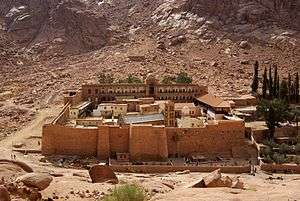South Sinai Governorate
| South Sinai Governorate | |||
|---|---|---|---|
| Governorate | |||
| |||
.svg.png) South Sinai Governorate on the map of Egypt | |||
| Coordinates: 29°03′N 33°50′E / 29.05°N 33.83°ECoordinates: 29°03′N 33°50′E / 29.05°N 33.83°E | |||
| Country |
| ||
| Seat | El Tor (capital) | ||
| Government | |||
| • Governor | Khaled Fouda Saddiq Mohammed [1] | ||
| Area | |||
| • Total | 33,140 km2 (12,800 sq mi) | ||
| Population (January 2018) | |||
| • Total | 104,000[2] | ||
| Time zone | UTC+2 (EET) | ||
| Website | South Sinai | ||
South Sinai Governorate (Egyptian Arabic: محافظة جنوب سيناء Muḥāfẓet Ganūb Sīnāʾ) is the least populated governorate of Egypt. It is located in the east of the country, encompassing the southern half of the Sinai Peninsula. Saint Catherine's Monastery, an Eastern Orthodox Church monastery and UNESCO World Heritage site of world renown, is located in the central part of the governorate.
History
Sharm El Sheikh has developed into a major tourist resort, but the industry has been severely affected by terrorism. In 2005, the resort was the site of terrorist attacks perpetrated by an extremist Islamist organisation. 88 people were killed, the majority of them Egyptians, and over 200 were wounded in the attack, making it the deadliest terrorist action in the country's history (even exceeding the Luxor massacre of 1997).[3] In February 2014, a tourist bus was attacked in Taba. The perpetrators killed the Egyptian bus driver and three South Korean tourists.
Demographics
According to population estimates from 2015 the majority of residents in the governorate live in urban areas, with an urbanization rate of 51.1%. Out of an estimated 167,426 people residing in the governorate, 85,502 people live in urban areas as opposed to only 81,924 in rural areas. [4] The Bedouin inhabit the Mount Sinai area. Due to poor accessibility, at times the orchards in the mountains have served to hide narcotics smugglers in the region.[5]
Landmarks

Saint Catherine's Monastery, an Eastern Orthodox Church monastery and UNESCO World Heritage site of world renown, is located in central part of the governorate, at the mouth of a gorge at the foot of Mount Sinai, in the city of Saint Catherine, Egypt. Built between 548 and 565, the monastery is one of the oldest working Christian monasteries in the world.[6] The site contains the world's oldest continually operating library, possessing many unique books including the Syriac Sinaiticus and, until 1859, the Codex Sinaiticus.[7][8]
Raithu Monastery is situated in El Tor. It was built on a site where some 40 monks were massacred in the 4th or 5th century.[9]
Cities and towns
Sites
References
- ↑ "رسمياً.. المحافظون الجدد ونوابهم يؤدون اليمين الدستورية أمام الرئيس". Almasry Alyoum (in Arabic). 30 August 2018.
- ↑ "الجهاز المركزي للتعبئة العامة والإحصاء". www.capmas.gov.eg. Retrieved 10 October 2018.
- ↑ "Bombers kill 88 at Egyptian resort". The Guardian. 23 July 2005. Retrieved 7 November 2016.
- ↑ "Population Estimates By Sex & Governorate 1/1/2015" (PDF). CAPMAS. Retrieved 23 October 2016.
- ↑ Marx, Emanuel (30 June 2013). Bedouin of Mount Sinai: An Anthropological Study of their Political Economy. Berghahn Books. p. 74. ISBN 978-0-85745-932-9.
- ↑ "Saint Catherine Area". UNESCO.
- ↑ Schrope, Mark (1 June 2015). "Medicine's Hidden Roots in an Ancient Manuscript". NY Times. Retrieved 1 June 2015.
- ↑ Jules Leroy; Peter Collin (2004). Monks and Monasteries of the Near East. Gorgias Press LLC. pp. 93–94. ISBN 978-1-59333-276-1.
- ↑ El-Din, Morsi Saad; Taher, Ayman; Romano, Luciano (1 February 1998). Sinai: The Site & the History : Essays. NYU Press. p. 114. ISBN 978-0-8147-2203-9.
External links
| Wikimedia Commons has media related to South Sinai Governorate. |
- South Sinai Governorate Official website

